Microstructural Evolution of Amphibole Peridotites in Åheim, Norway, and the Implications for Seismic Anisotropy in the Mantle Wedge
Abstract
1. Introduction
2. Geological Setting and Sample Description
3. Materials and Methods
3.1. The Chemical Composition of Minerals
3.2. Measurement of LPO and Seismic Anisotropy
3.3. Measurement of Water Content in Olivine
3.4. Dislocation Microstructure
4. Results
4.1. Microstructures
4.2. Chemical Compositions of Minerals
4.3. LPO of Minerals
4.4. Seismic Velocity and Anisotropy
4.5. Water Content of Olivine
4.6. Dislocation Microstructure of Olivine
5. Discussion
5.1. Development of LPO of Olivine
5.2. The Deformation History of Åheim Peridotite
5.3. Implications for the Seismic Anisotropy
6. Conclusions
Author Contributions
Funding
Acknowledgments
Conflicts of Interest
References
- Ben Ismail, W.; Mainprice, D. An olivine fabric database: An overview of upper mantle fabrics and seismic anisotropy. Tectonophysics 1998, 296, 145–157. [Google Scholar] [CrossRef]
- Jung, H. Crystal preferred orientations of olivine, orthopyroxene, serpentine, chlorite, and amphibole, and implications for seismic anisotropy in subduction zones: A review. Geosci. J. 2017, 21, 985–1011. [Google Scholar] [CrossRef]
- Karato, S.; Jung, H.; Katayama, I.; Skemer, P. Geodynamic significance of seismic anisotropy of the upper mantle: New insights from laboratory studies. Annu. Rev. Earth Planet. Sci. 2008, 36, 59–95. [Google Scholar] [CrossRef]
- Nicolas, A.; Christensen, N.I. Formation of anisotropy in upper mantle peridotites: A review. Geodyn. Ser. 1987, 16, 111–123. [Google Scholar] [CrossRef]
- Skemer, P.; Hansen, L.N. Inferring upper-mantle flow from seismic anisotropy: An experimental perspective. Tectonophysics 2016, 668, 1–14. [Google Scholar] [CrossRef]
- Boneh, Y.; Skemer, P. The effect of deformation history on the evolution of olivine CPO. Earth Planet. Sci. Lett. 2014, 406, 213–222. [Google Scholar] [CrossRef]
- Jung, H.; Karato, S. Water-induced fabric transitions in olivine. Science 2001, 293, 1460–1463. [Google Scholar] [CrossRef]
- Jung, H.; Katayama, I.; Jiang, Z.; Hiraga, T.; Karato, S. Effect of water and stress on the lattice-preferred orientation of olivine. Tectonophysics 2006, 421, 1–22. [Google Scholar] [CrossRef]
- Katayama, I.; Jung, H.; Karato, S. New type of olivine fabric from deformation experiments at modest water content and low stress. Geology 2004, 32, 1045–1048. [Google Scholar] [CrossRef]
- Ohuchi, T.; Kawazoe, T.; Nishihara, Y.; Nishiyama, N.; Irifune, T. High pressure and temperature fabric transitions in olivine and variations in upper mantle seismic anisotropy. Earth Planet. Sci. Lett. 2011, 304, 55–63. [Google Scholar] [CrossRef]
- Soustelle, V.; Manthilake, G. Deformation of olivine-orthopyroxene aggregates at high pressure and temperature: Implications for the seismic properties of the asthenosphere. Tectonophysics 2017, 694, 385–399. [Google Scholar] [CrossRef]
- Long, M.D.; van der Hilst, R.D. Shear wave splitting from local events beneath the Ryukyu arc: Trench-parallel anisotropy in the mantle wedge. Phys. Earth Planet. Inter. 2006, 155, 300–312. [Google Scholar] [CrossRef]
- Nakajima, J.; Hasegawa, A. Shear-wave polarization anisotropy and subduction-induced flow in the mantle wedge of northeastern Japan. Earth Planet. Sci. Lett. 2004, 225, 365–377. [Google Scholar] [CrossRef]
- Precigout, J.; Almqvist, B.S.G. The Ronda peridotite (Spain): A natural template for seismic anisotropy in subduction wedges. Geophys. Res. Lett. 2014, 41, 8752–8758. [Google Scholar] [CrossRef]
- Jung, H.; Mo, W.; Green, H.W. Upper mantle seismic anisotropy resulting from pressure-induced slip transition in olivine. Nat. Geosci. 2009, 2, 73–77. [Google Scholar] [CrossRef]
- Wang, Q.; Xia, Q.K.; O’Reilly, S.Y.; Griffin, W.L.; Beyer, E.E.; Brueckner, H.K. Pressure- and stress-induced fabric transition in olivine from peridotites in the Western Gneiss Region (Norway): Implications for mantle seismic anisotropy. J. Metamorph. Geol. 2013, 31, 93–111. [Google Scholar] [CrossRef]
- Cao, Y.; Jung, H.; Song, S.G. Olivine fabrics and tectonic evolution of fore-arc mantles: A natural perspective from the Songshugou dunite and harzburgite in the Qinling orogenic belt, central China. Geochem. Geophys. Geosyst. 2017, 18, 907–934. [Google Scholar] [CrossRef]
- Hansen, L.N.; Zimmerman, M.E.; Kohlstedt, D.L. Grain boundary sliding in San Carlos olivine: Flow law parameters and crystallographic-preferred orientation. J. Geophys. Res. Solid Earth 2011, 116, 16. [Google Scholar] [CrossRef]
- Precigout, J.; Hirth, G. B-type olivine fabric induced by grain boundary sliding. Earth Planet. Sci. Lett. 2014, 395, 231–240. [Google Scholar] [CrossRef]
- Sundberg, M.; Cooper, R.F. Crystallographic preferred orientation produced by diffusional creep of harzburgite: Effects of chemical interactions among phases during plastic flow. J. Geophys. Res. Solid Earth 2008, 113, 16. [Google Scholar] [CrossRef]
- Holtzman, B.K.; Kohlstedt, D.L.; Zimmerman, M.E.; Heidelbach, F.; Hiraga, T.; Hustoft, J. Melt segregation and strain partitioning: Implications for seismic anisotropy and mantle flow. Science 2003, 301, 1227–1230. [Google Scholar] [CrossRef]
- Qi, C.; Hansen, L.N.; Wallis, D.; Holtzman, B.K.; Kohlstedt, D.L. Crystallographic preferred orientation of olivine in sheared partially molten rocks: The source of the“ a-c Switch”. Geochem. Geophys. Geosyst. 2018, 19, 316–336. [Google Scholar] [CrossRef]
- Jung, S.; Jung, H.; Austrheim, H. Characterization of olivine fabrics and mylonite in the presence of fluid and implications for seismic anisotropy and shear localization. Earth Planets Space 2014, 66, 21. [Google Scholar] [CrossRef]
- Kim, D.; Jung, H. Deformation microstructures of olivine and chlorite in chlorite peridotites from Almklovdalen in the Western Gneiss Region, southwest Norway, and implications for seismic anisotropy. Int. Geol. Rev. 2015, 57, 650–668. [Google Scholar] [CrossRef]
- Behr, W.M.; Smith, D. Deformation in the mantle wedge associated with Laramide flat-slab subduction. Geochem. Geophys. Geosyst. 2016, 17, 2643–2660. [Google Scholar] [CrossRef]
- Puelles, P.; Abalos, B.; Ibarguchi, J.I.G.; Sarrionandia, F.; Carracedo, M.; Fernandez-Armas, S. Petrofabric and seismic properties of lithospheric mantle xenoliths from the Calatrava volcanic field (Central Spain). Tectonophysics 2016, 683, 200–215. [Google Scholar] [CrossRef]
- Fumagalli, P.; Poli, S. Experimentally determined phase relations in hydrous peridotites to 6.5 GPa and their consequences on the dynamics of subduction zones. J. Petrol. 2005, 46, 555–578. [Google Scholar] [CrossRef]
- Hacker, B.R.; Abers, G.A.; Peacock, S.M. Subduction factory 1. Theoretical mineralogy, densities, seismic wave speeds, and H2O contents. J. Geophys. Res. Solid Earth 2003, 108, 26. [Google Scholar] [CrossRef]
- Ohtani, E. Water in the mantle. Elements 2005, 1, 25–30. [Google Scholar] [CrossRef]
- Wada, I.; Behn, M.D.; Shaw, A.M. Effects of heterogeneous hydration in the incoming plate, slab rehydration, and mantle wedge hydration on slab-derived H2O flux in subduction zones. Earth Planet. Sci. Lett. 2012, 353, 60–71. [Google Scholar] [CrossRef]
- Almqvist, B.S.G.; Mainprice, D. Seismic properties and anisotropy of the continental crust: Predictions based on mineral texture and rock microstructure. Rev. Geophys. 2017, 55, 367–433. [Google Scholar] [CrossRef]
- Lee, J.; Jung, H.; Klemd, R.; Tarling, M.S.; Konopelko, D. Lattice preferred orientation of talc and implications for seismic anisotropy in subduction zones. Earth Planet. Sci. Lett. 2020, 537, 1–11. [Google Scholar] [CrossRef]
- Mainprice, D.; Ildefonse, B. Seismic anisotropy of subduction zone minerals–contribution of hydrous phases. In Subduction Zone Geodynamics; Springer: Berlin, Germany, 2009; pp. 63–84. [Google Scholar]
- Mookherjee, M.; Mainprice, D. Unusually large shear wave anisotropy for chlorite in subduction zone settings. Geophys. Res. Lett. 2014, 41, 1506–1513. [Google Scholar] [CrossRef]
- Walpole, J.; Wookey, J.; Kendall, J.M.; Masters, T.G. Seismic anisotropy and mantle flow below subducting slabs. Earth Planet. Sci. Lett. 2017, 465, 155–167. [Google Scholar] [CrossRef]
- Liu, X.; Zhao, D.P. Depth-varying azimuthal anisotropy in the Tohoku subduction channel. Earth Planet. Sci. Lett. 2017, 473, 33–43. [Google Scholar] [CrossRef]
- Long, M.D. Constraints on subduction geodynamics from seismic anisotropy. Rev. Geophys. 2013, 51, 76–112. [Google Scholar] [CrossRef]
- Jung, H. Seismic anisotropy produced by serpentine in mantle wedge. Earth Planet. Sci. Lett. 2011, 307, 535–543. [Google Scholar] [CrossRef]
- Katayama, I.; Hirauchi, H.; Michibayashi, K.; Ando, J. Trench-parallel anisotropy produced by serpentine deformation in the hydrated mantle wedge. Nature 2009, 461, 1114–1117. [Google Scholar] [CrossRef]
- Nagaya, T.; Walker, A.M.; Wookey, J.; Wallis, S.R.; Ishii, K.; Kendall, J.M. Seismic evidence for flow in the hydrated mantle wedge of the Ryukyu subduction zone. Sci. Rep. 2016, 6, 13. [Google Scholar] [CrossRef]
- Kang, H.; Jung, H. Lattice-preferred orientation of amphibole, chlorite, and olivine found in hydrated mantle peridotites from Bjørkedalen, southwestern Norway, and implications for seismic anisotropy. Tectonophysics 2019, 750, 137–152. [Google Scholar] [CrossRef]
- Ji, S.C.; Shao, T.B.; Michibayashi, K.; Long, C.X.; Wang, Q.; Kondo, Y.; Zhao, W.H.; Wang, H.C.; Salisbury, M.H. A new calibration of seismic velocities, anisotropy, fabrics, and elastic moduli of amphibole-rich rocks. J. Geophys. Res. Solid Earth 2013, 118, 4699–4728. [Google Scholar] [CrossRef]
- Kim, J.; Jung, H. New crystal preferred orientation of amphibole experimentally found in simple shear. Geophys. Res. Lett. 2019, 46, 12996–13005. [Google Scholar] [CrossRef]
- Ko, B.; Jung, H. Crystal preferred orientation of an amphibole experimentally deformed by simple shear. Nat. Commun. 2015, 6, 10. [Google Scholar] [CrossRef]
- Cao, Y.; Song, S.G.; Su, L.; Jung, H.; Niu, Y.L. Highly refractory peridotites in Songshugou, Qinling orogen: Insights into partial melting and melt/fluid-rock reactions in forearc mantle. Lithos 2016, 252, 234–254. [Google Scholar] [CrossRef]
- Evans, B.W. Metamorphism of alpine metaperidotite and serpentinite. Annu. Rev. Earth Planet. Sci. 1977, 5, 397–447. [Google Scholar] [CrossRef]
- Austrheim, H. Fluid and deformation induced metamorphic processes around Moho beneath continent collision zones: Examples from the exposed root zone of the Caledonian mountain belt, W-Norway. Tectonophysics 2013, 609, 620–635. [Google Scholar] [CrossRef]
- Hacker, B.R.; Andersen, T.B.; Johnston, S.; Kylander-Clark, A.R.C.; Peterman, E.M.; Walsh, E.O.; Young, D. High-temperature deformation during continental-margin subduction & exhumation: The ultrahigh-pressure Western Gneiss Region of Norway. Tectonophysics 2010, 480, 149. [Google Scholar] [CrossRef]
- Soper, N.J.; Strachan, R.A.; Holdsworth, R.E.; Gayer, R.A.; Greiling, R.O. Sinistral transpression and the closure of Iapetus. J. Geol. Soc. 1992, 149, 871–880. [Google Scholar] [CrossRef]
- Gee, D.G. Tectonic model for central part of Scandinavian Caledonides. Am. J. Sci. 1975, A275, 468–515. [Google Scholar]
- Roberts, D. The Scandinavian Caledonides: Event chronology, palaeogeographic settings and likely, modern analogues. Tectonophysics 2003, 365, 283–299. [Google Scholar] [CrossRef]
- Beyer, E.E.; Brueckner, H.K.; Griffin, W.L.; O’Reilly, S.Y. Laurentian provenance of archean mantle fragments in the proterozoic baltic crust of the Norwegian Caledonides. J. Petrol. 2012, 53, 1357–1383. [Google Scholar] [CrossRef]
- Brueckner, H.K.; Carswell, D.A.; Griffin, W.L.; Medaris, L.G.; Van Roermund, H.L.M.; Cuthbert, S.J. The mantle and crustal evolution of two garnet peridotite suites from the Western Gneiss Region, Norwegian Caledonides: An isotopic investigation. Lithos 2010, 117, 1–19. [Google Scholar] [CrossRef]
- Carswell, D.A. The metamorphic evolution of Mg-Cr type Norwegian garnet peridotites. Lithos 1986, 19, 279–297. [Google Scholar] [CrossRef]
- Cordellier, F.; Boudier, F.; Boullier, A.M. Structural study of the Almklovdalen peridotite massif (southern-Norway). Tectonophysics 1981, 77, 257–281. [Google Scholar] [CrossRef]
- Jamtveit, B.; Carswell, D.A.; Mearns, E.W. Chronology of the high-pressure metamorphism of Norwegian garnet peridotites pyroxenites. J. Metamorph. Geol. 1991, 9, 125–139. [Google Scholar] [CrossRef]
- Kylander-Clark, A.R.C.; Hacker, B.R.; Mattinson, J.M. Slow exhumation of UHP terranes: Titanite and rutile ages of the Western Gneiss Region, Norway. Earth Planet. Sci. Lett. 2008, 272, 531–540. [Google Scholar] [CrossRef]
- Lapen, T.J.; Medaris, L.G.; Beard, B.L.; Johnson, C.M. The Sandvik peridotite, Gurskoy, Norway: Three billion years of mantle evolution in the Baltica lithosphere. Lithos 2009, 109, 145–154. [Google Scholar] [CrossRef]
- Vrijmoed, J.C.; Van Roermund, H.L.M.; Davies, G.R. Evidence for diamond-grade ultra-high pressure metamorphism and fluid interaction in the Svartberget Fe-Ti garnet peridotite-websterite body, Western Gneiss Region, Norway. Mineral. Petrol. 2006, 88, 381–405. [Google Scholar] [CrossRef]
- Austrheim, H.; Corfu, F.; Bryhni, I.; Andersen, T.B. The Proterozoic Hustad igneous complex: A low strain enclave with a key to the history of the Western Gneiss Region of Norway. Precambrian Res. 2003, 120, 149–175. [Google Scholar] [CrossRef]
- Hacker, B.R. Ascent of the ultrahigh-pressure Western Gneiss Region, Norway. Geol. Soc. Am. Spec. Pap. 2007, 419, 171–184. [Google Scholar] [CrossRef]
- Dobrzhinetskaya, L.F.; Eide, E.A.; Larsen, R.B.; Sturt, B.A.; Tronnes, R.G.; Smith, D.C.; Taylor, W.R.; Posukhova, T.V. Microdiamond in high-grade metamorhic rocks of the Western Gneiss Region, Norway. Geology 1995, 23, 597–600. [Google Scholar] [CrossRef]
- Root, D.B.; Hacker, B.R.; Gans, P.B.; Ducea, M.N.; Eide, E.A.; Mosenfelder, J.L. Discrete ultrahigh-pressure domains in the Western Gneiss Region, Norway: Implications for formation and exhumation. J. Metamorph. Geol. 2005, 23, 45–61. [Google Scholar] [CrossRef]
- Kostenko, O.; Jamtveit, B.; Austrheim, H.; Pollok, K.; Putnis, C. The mechanism of fluid infiltration in peridotites at Almklovdalen, western Norway. Geofluids 2002, 2, 203–215. [Google Scholar] [CrossRef]
- O’Neill, H.S.C.; Wall, V.J. The olivine-orthopyroxene-spinel oxygen geobarometer, the nickel precipitation curve, and the oxygen fugacity of the Earth’s upper mantle. J. Petrol. 1987, 28, 1169–1191. [Google Scholar] [CrossRef]
- Witteickschen, G.; Seck, H.A. Solubility of Ca and Al in orthopyroxene from spinel peridotite—An improved version of an empirical geothermometer. Contrib. Mineral. Petrol. 1991, 106, 431–439. [Google Scholar] [CrossRef]
- O’Neill, H.S.C. The transition between spinel lherzolite and garnet lherzolite, and its use as a geobarometer. Contrib. Mineral. Petrol. 1981, 77, 185–194. [Google Scholar] [CrossRef]
- Panozzo, R. Two-dimensional strain from the orientation of lines in a plane. J. Struct. Geol. 1984, 6, 215–221. [Google Scholar] [CrossRef]
- Skemer, P.; Katayama, I.; Jiang, Z.; Karato, S. The misorientation index: Development of a new method for calculating the strength of lattice-preferred orientation. Tectonophysics 2005, 411, 157–167. [Google Scholar] [CrossRef]
- Bunge, H.-J. Texture Analysis in Materials Science: Mathematical Models; Butterworths: London, UK, 1982. [Google Scholar]
- Mainprice, D. A fortran program to calculate seismic anisotropy from the lattice preferred orientation of minerals. Comput. Geosci. 1990, 16, 385–393. [Google Scholar] [CrossRef]
- Abramson, E.H.; Brown, J.M.; Slutsky, L.J.; Zaug, J. The elastic constants of San Carlos olivine to 17 GPa. J. Geophys. Res. 1997, 102, 12253–12263. [Google Scholar] [CrossRef]
- Brown, J.M.; Abramson, E.H. Elasticity of calcium and calcium-sodium amphiboles. Phys. Earth Planet. Inter. 2016, 261, 161–171. [Google Scholar] [CrossRef]
- Bezacier, L.; Reynard, B.; Bass, J.D.; Sanchez-Valle, C.; Van de Moortele, B.V. Elasticity of antigorite, seismic detection of serpentinites, and anisotropy in subduction zones. Earth Planet. Sci. Lett. 2010, 289, 198–208. [Google Scholar] [CrossRef]
- Pera, E.; Mainprice, D.; Burlini, L. Anisotropic seismic properties of the upper mantle beneath the Torre Alfina area (Northern Appennines, Central Italy). Tectonophysics 2003, 370, 11–30. [Google Scholar] [CrossRef]
- Paterson, M.S. The determination of hydroxyl by infrared-absorption in quartz, silicate-glasses and similar materials. Bull. Mineral. 1982, 105, 20–29. [Google Scholar] [CrossRef]
- Jung, H.; Karato, S. Effects of water on dynamically recrystallized grain-size of olivine. J. Struct. Geol. 2001, 23, 1337–1344. [Google Scholar] [CrossRef]
- Karato, S. Scanning electron microscope observation of dislocations in olivine. Phys. Chem. Miner. 1987, 14, 245–248. [Google Scholar] [CrossRef]
- Kohlstedt, D.L.; Goetze, C.; Durham, W.B.; Vandersande, J. New technique for decorating dislocations in olivine. Science 1976, 191, 1045–1046. [Google Scholar] [CrossRef]
- Gifkins, R.C. Optical Microscopy of Metals; Elsevier: New York, NY, USA, 1970. [Google Scholar]
- Chatzaras, V.; Kruckenberg, S.C.; Cohen, S.M.; Medaris, L.G.; Withers, A.C.; Bagley, B. Axial-type olivine crystallographic preferred orientations: The effect of strain geometry on mantle texture. J. Geophys. Res. Solid Earth 2016, 121, 4895–4922. [Google Scholar] [CrossRef]
- Prelicz, R.M. Seismic Anisotropy in Peridotites from the Western Gneiss Region (Norway) Laboratory Measurements at High PT Conditions and Fabric Based Model Predictions. Ph.D. Thesis, ETH Zürich, Zürich, Switzerland, 2005. [Google Scholar]
- Jung, H. Deformation fabrics of olivine in Val Malenco peridotite found in Italy and implications for the seismic anisotropy in the upper mantle. Lithos 2009, 109, 341–349. [Google Scholar] [CrossRef]
- Khisina, N.R.; Wirth, R.; Andrut, M.; Ukhanov, A.V. Extinction and intrinsic mode of hydrogen occurrence in natural olivine: FTIR and TEM investigation. Phys. Chem. Miner. 2001, 28, 291–301. [Google Scholar]
- Miller, G.H.; Rossman, G.R.; Harlow, G.E. The natural occurrence of hydroxide in olivine. Phys. Chem. Miner. 1987, 14, 461–472. [Google Scholar] [CrossRef]
- Hirth, G.; Kohlstedt, D. Rheology of the upper mantle and the mantle wedge: A view from the experimentalists. Geophys. Monogr. 2003, 138, 83–105. [Google Scholar] [CrossRef]
- Ashby, M.F.; Verral, R.A. Diffusion accommodated flow and superplasticity. Acta Metall. 1973, 21, 149–163. [Google Scholar] [CrossRef]
- Goldsby, D.L.; Kohlstedt, D.L. Superplastic deformation of ice: Experimental observations. J. Geophys. Res. Solid Earth 2001, 106, 11017–11030. [Google Scholar] [CrossRef]
- Katayama, I.; Karato, S. Effect of temperature on the B- to C-type olivine fabric transition and implication for flow pattern in subduction zones. Phys. Earth Planet. Inter. 2006, 157, 33–45. [Google Scholar] [CrossRef]
- Frese, K.; Trommsdorff, V.; Kunze, K. Olivine 100 normal to foliation: Lattice preferred orientation in prograde garnet peridotite formed at high H2O activity, Cima di Gagnone (Central Alps). Contrib. Mineral. Petrol. 2003, 145, 75–86. [Google Scholar] [CrossRef]
- Katayama, I.; Karato, S.; Brandon, M. Evidence of high water content in the deep upper mantle inferred from deformation microstructures. Geology 2005, 33, 613–616. [Google Scholar] [CrossRef]
- Jung, H.; Lee, J.; Ko, B.; Jung, S.; Park, M.; Cao, Y.; Song, S.G. Natural type-C olivine fabrics in garnet peridotites in North Qaidam UHP collision belt, NW China. Tectonophysics 2013, 594, 91–102. [Google Scholar] [CrossRef]
- Park, M.; Jung, H.; Kil, Y. Petrofabrics of olivine in a rift axis and rift shoulder and their implications for seismic anisotropy beneath the Rio Grande rift. Isl. Arc. 2014, 23, 299–311. [Google Scholar] [CrossRef]
- Boneh, Y.; Morales, L.F.G.; Kaminski, E.; Skemer, P. Modeling olivine CPO evolution with complex deformation histories: Implications for the interpretation of seismic anisotropy in the mantle. Geochem. Geophys. Geosyst. 2015, 16, 3436–3455. [Google Scholar] [CrossRef]
- Long, M.D.; Silver, P.G. The subduction zone flow field from seismic anisotropy: A global view. Science 2008, 319, 315–318. [Google Scholar] [CrossRef] [PubMed]
- Mehl, L.; Hacker, B.R.; Hirth, G.; Kelemen, P.B. Arc-parallel flow within the mantle wedge: Evidence from the accreted Talkeetna arc, south central Alaska. J. Geophys. Res. Solid Earth 2003, 108, 18. [Google Scholar] [CrossRef]
- Savage, M.K. Seismic anisotropy and mantle deformation: What have we learned from shear wave splitting? Rev. Geophys. 1999, 37, 65–106. [Google Scholar] [CrossRef]
- Smith, G.P.; Wiens, D.A.; Fischer, K.M.; Dorman, L.M.; Webb, S.C.; Hildebrand, J.A. A complex pattern of mantle flow in the Lau backarc. Science 2001, 292, 713–716. [Google Scholar] [CrossRef]
- Cao, Y.; Jung, H.; Song, S.G.; Park, M.; Jung, S.; Lee, J. Plastic deformation and seismic properties in fore-arc mantles: A petrofabric analysis of the Yushigou Harzburgites, North Qilian Suture Zone, NW China. J. Petrol. 2015, 56, 1897–1943. [Google Scholar] [CrossRef]
- Huang, Z.C.; Zhao, D.P.; Wang, L.S. Shear wave anisotropy in the crust, mantle wedge, and subducting Pacific slab under northeast Japan. Geochem. Geophys. Geosyst. 2011, 12, 17. [Google Scholar] [CrossRef]
- Long, M.D.; Wirth, E.A. Mantle flow in subduction systems: The mantle wedge flow field and implications for wedge processes. J. Geophys. Res. Solid Earth 2013, 118, 583–606. [Google Scholar] [CrossRef]
- Soto, G.L.; Ni, J.F.; Grand, S.P.; Sandvol, E.; Valenzuela, R.W.; Speziale, M.G.; Gonzalez, J.M.G.; Reyes, T.D. Mantle flow in the Rivera-Cocos subduction zone. Geophys. J. Int. 2009, 179, 1004–1012. [Google Scholar] [CrossRef]
- Audet, P.; Bostock, M.G.; Christensen, N.I.; Peacock, S.M. Seismic evidence for overpressured subducted oceanic crust and megathrust fault sealing. Nature 2009, 457, 76–78. [Google Scholar] [CrossRef]
- Kim, Y.; Clayton, R.W.; Jackson, J.M. Geometry and seismic properties of the subducting Cocos plate in central Mexico. J. Geophys. Res. Solid Earth 2010, 115, 22. [Google Scholar] [CrossRef]
- Kodaira, S.; Iidaka, T.; Kato, A.; Park, J.O.; Iwasaki, T.; Kaneda, Y. High pore fluid pressure may cause silent slip in the Nankai Trough. Science 2004, 304, 1295–1298. [Google Scholar] [CrossRef] [PubMed]
- Peacock, S.M.; Christensen, N.I.; Bostock, M.G.; Audet, P. High pore pressures and porosity at 35 km depth in the Cascadia subduction zone. Geology 2011, 39, 471–474. [Google Scholar] [CrossRef]
- Shelly, D.R.; Beroza, G.C.; Ide, S.; Nakamula, S. Low-frequency earthquakes in Shikoku, Japan, and their relationship to episodic tremor and slip. Nature 2006, 442, 188–191. [Google Scholar] [CrossRef] [PubMed]
- Kim, Y.; Clayton, R.W.; Asimow, P.D.; Jackson, J.M. Generation of talc in the mantle wedge and its role in subduction dynamics in central Mexico. Earth Planet. Sci. Lett. 2013, 384, 81–87. [Google Scholar] [CrossRef]
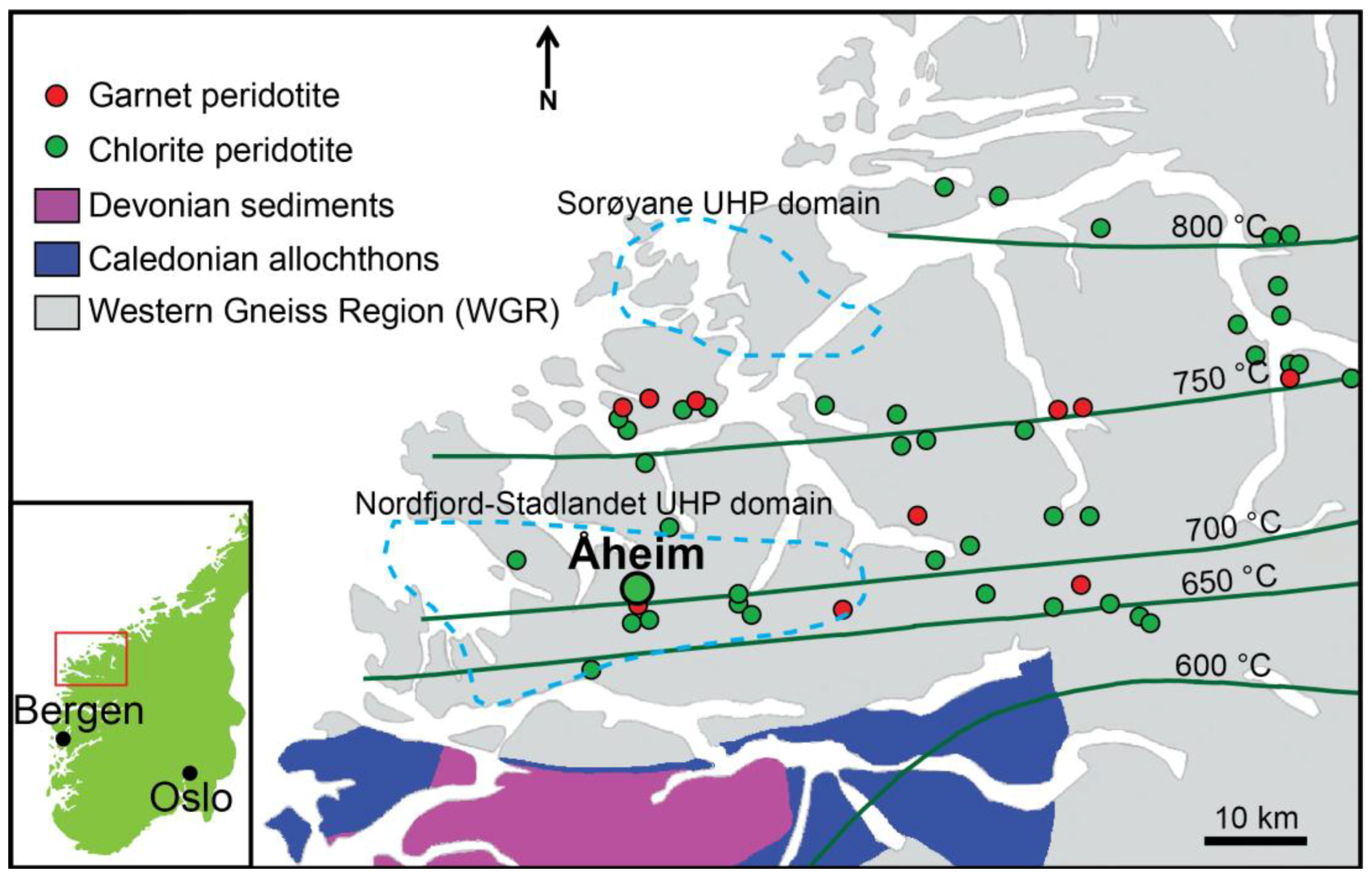

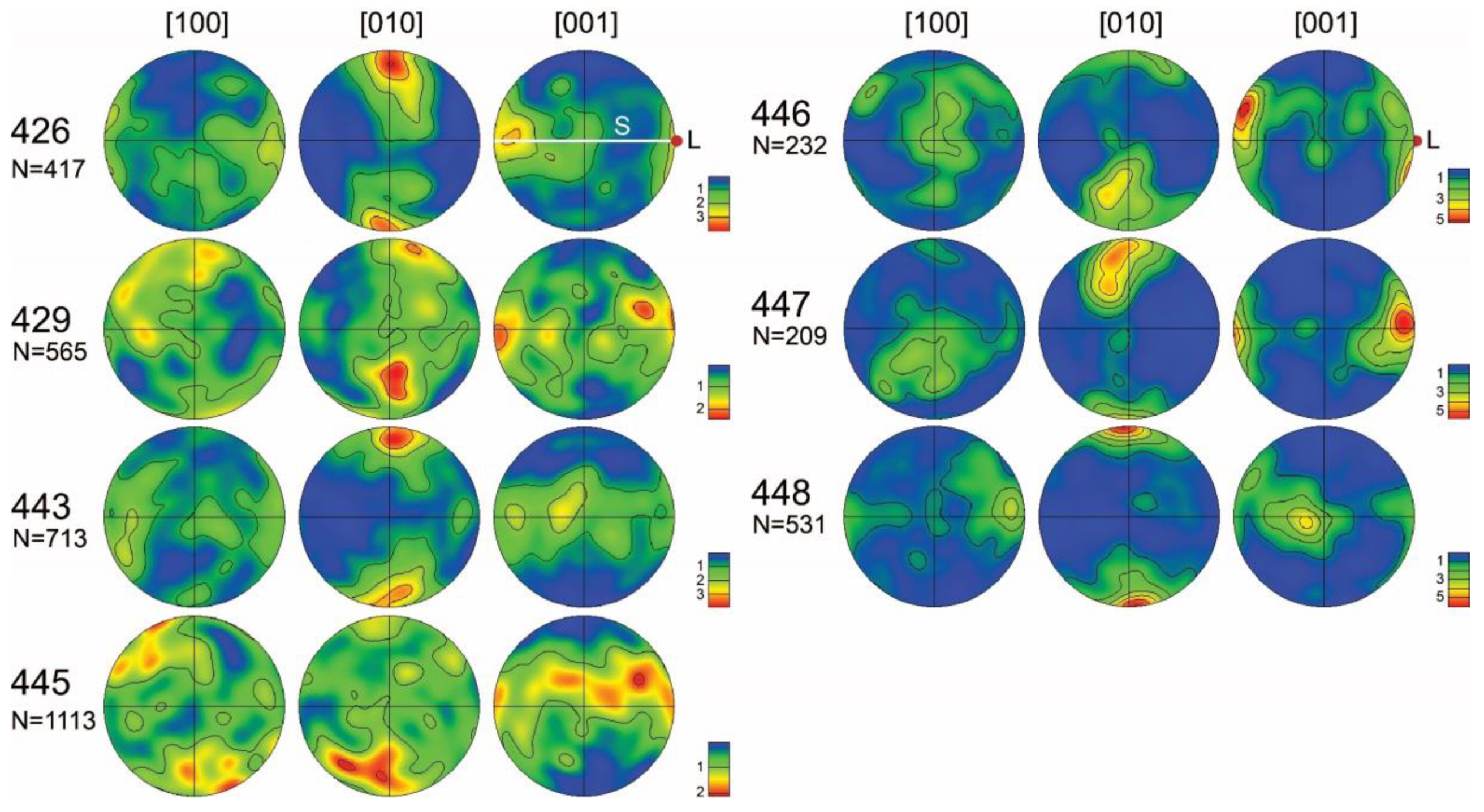
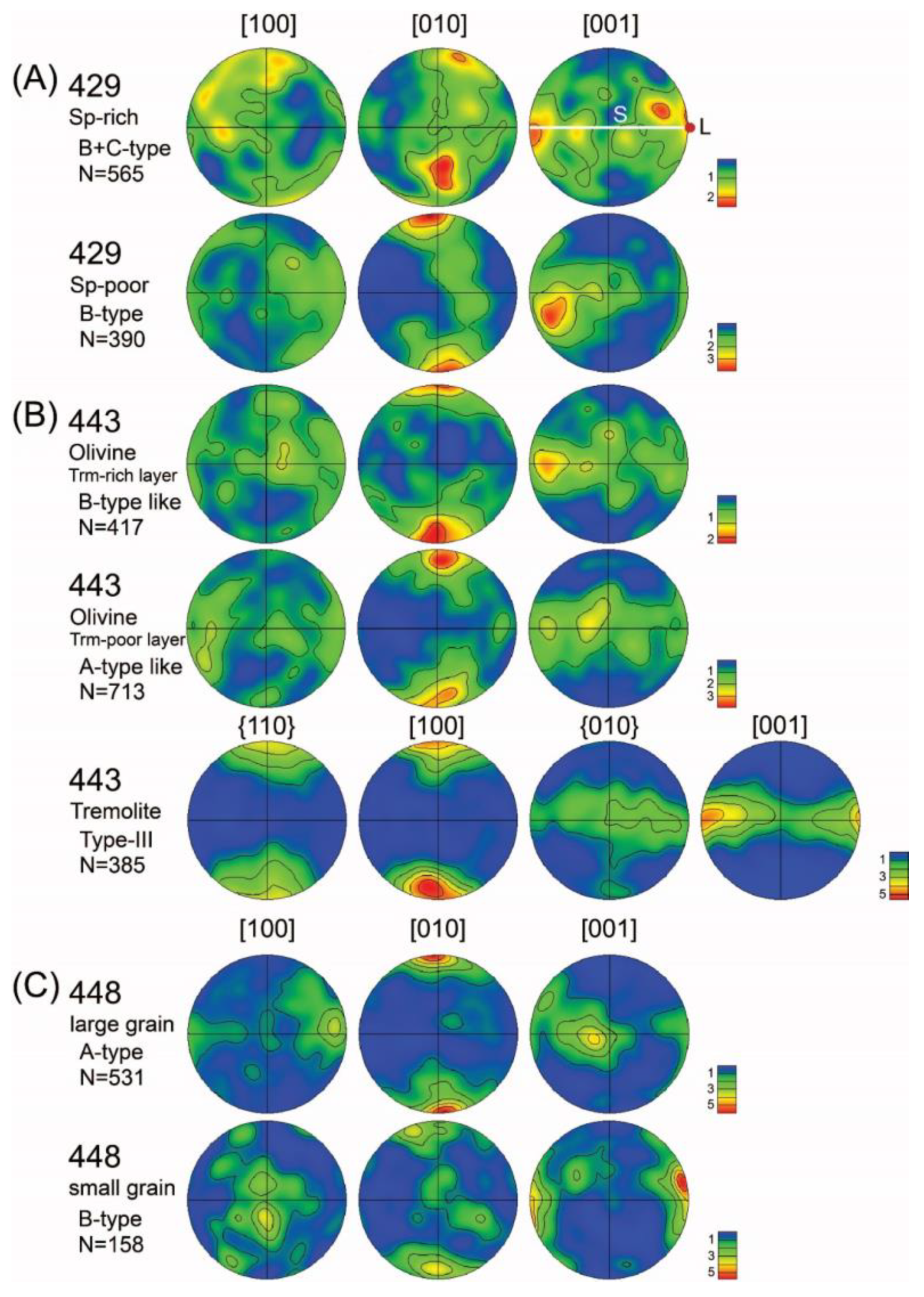
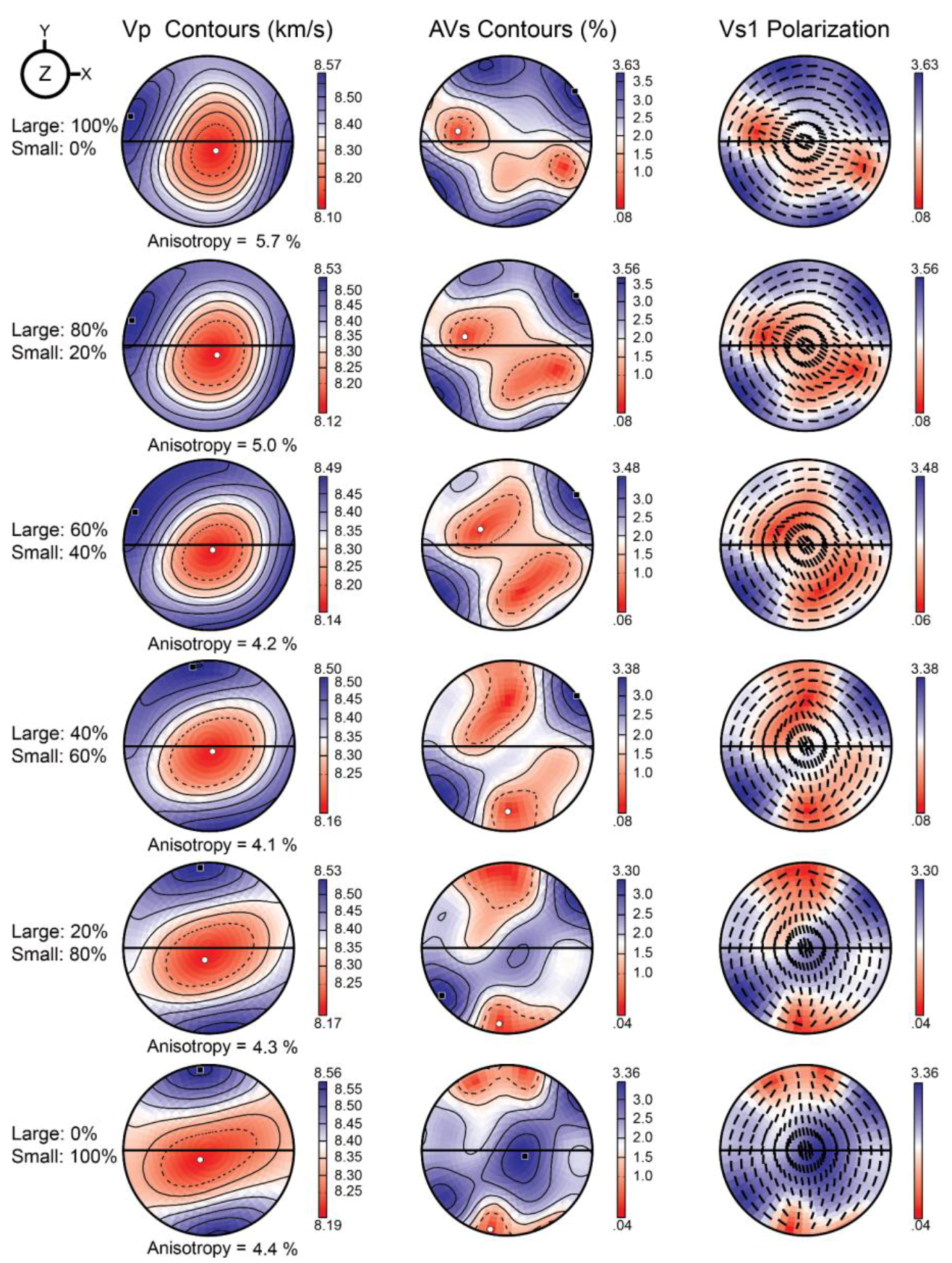
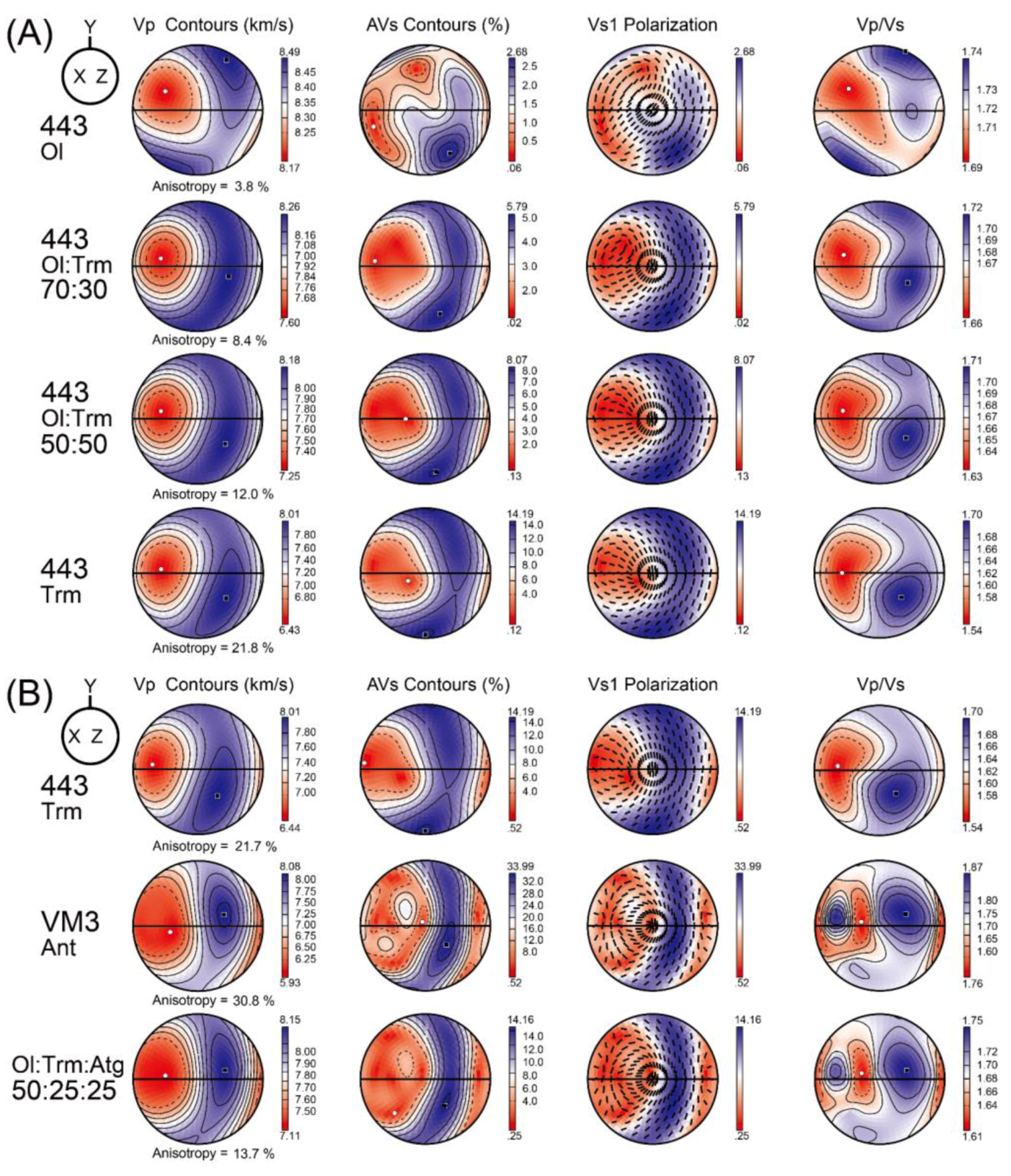
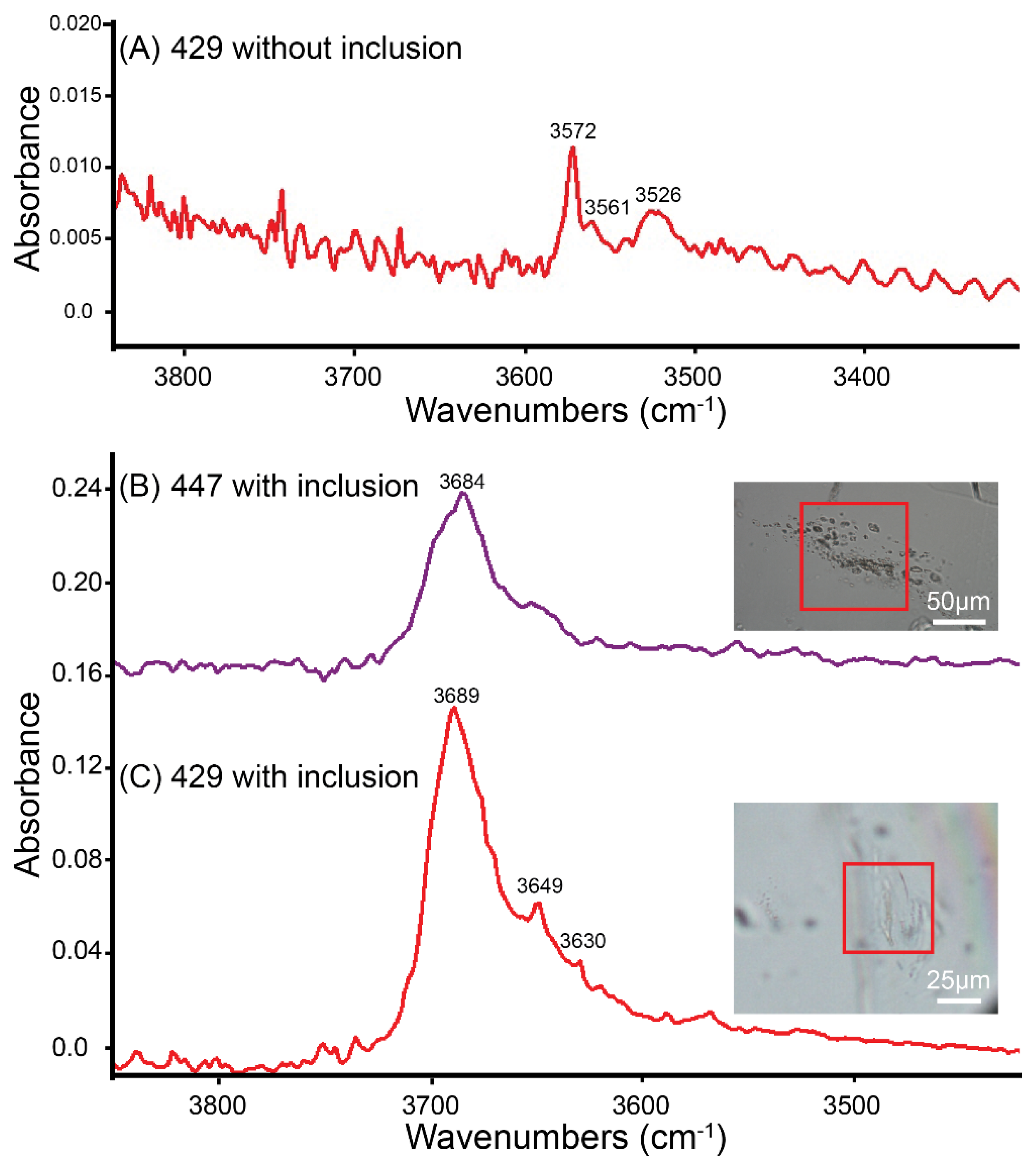
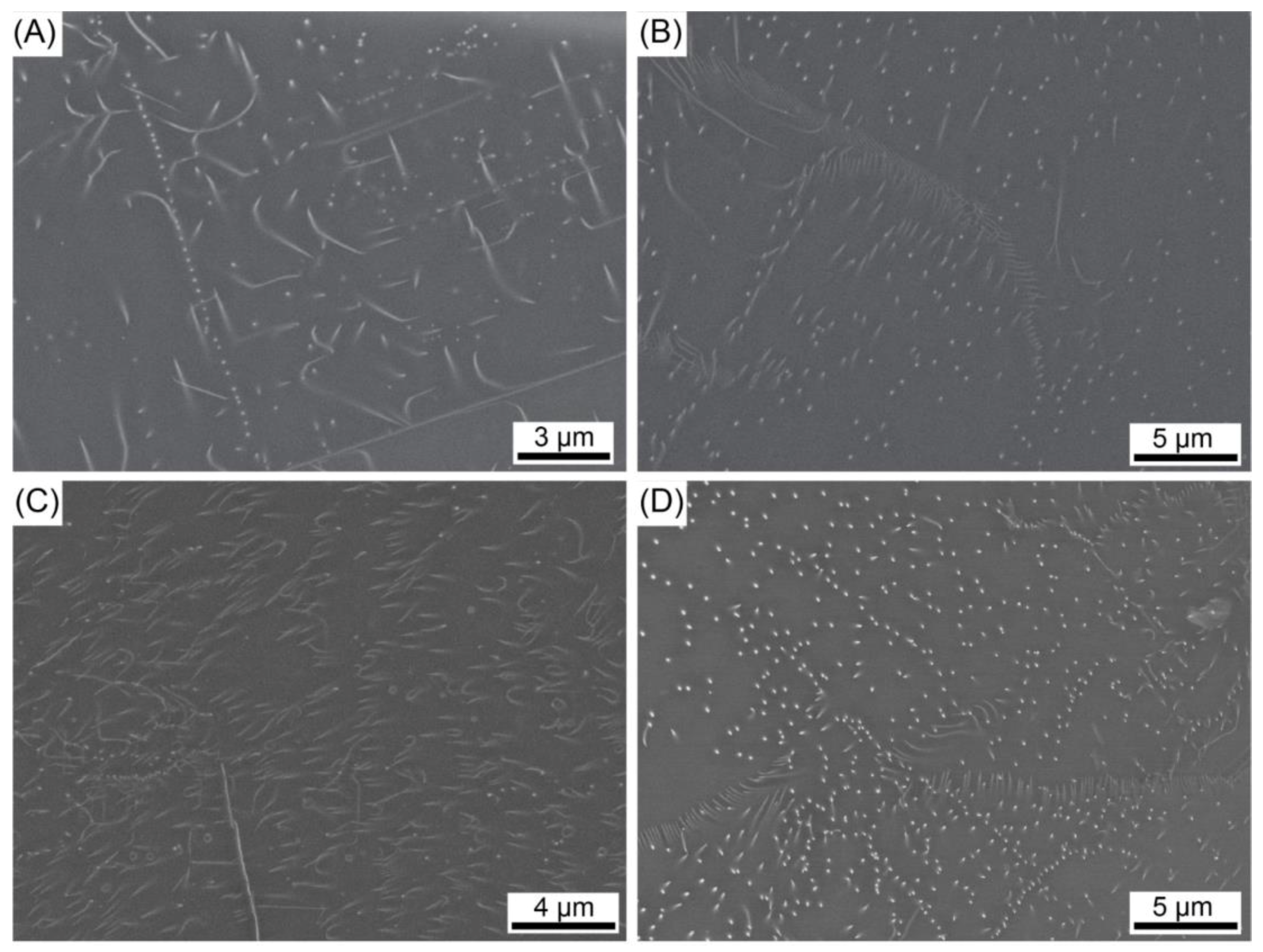
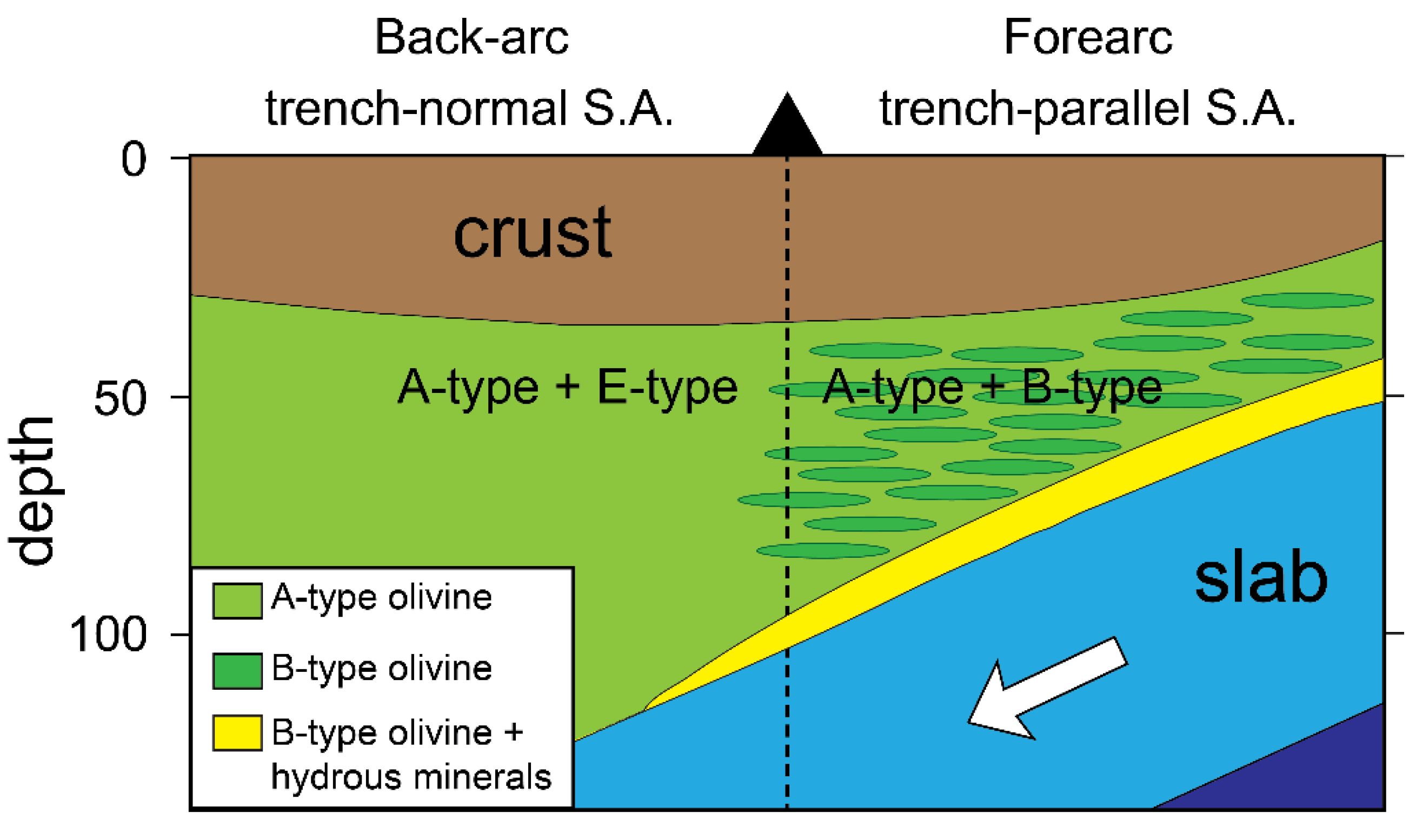
| Sample | LPO Type of Olivine | Water Content of Olivine 1 (ppm H/Si) | Average Grain Size 2 (mm) | M-Index 3 | J-Index 4 | |
|---|---|---|---|---|---|---|
| 426 | A + B-type | 500 ± 50 | 0.48 | 0.09 | 2.98 | |
| 429 | Spinel-rich | B + C-type | 320 ± 50 | 0.36 | 0.05 | 2.00 |
| Spinel-poor | B-type | 0.32 | 0.08 | 2.86 | ||
| 443 | Tremolite-rich | B-type | 230 ± 50 | 0.35 | 0.05 0.13 * | 2.34 5.89 * |
| Tremolite-poor | A-type | 0.7 | 0.08 | 2.66 | ||
| 445 | B + C-type | 500 ± 50 | 0.51 | 0.05 | 1.89 | |
| 446 | B-type | 310 ± 50 | 0.46 | 0.09 | 3.61 | |
| 447 | B-type | 430 ± 50 | 0.38 | 0.19 | 4.55 | |
| 448 | Large grain | A-type | 300 ± 50 | 1.2 | 0.1 | 3.25 |
| Small grain | B-type | 0.35 | 0.08 | 4.46 | ||
| Sample | 447 | 448 | ||||||||
|---|---|---|---|---|---|---|---|---|---|---|
| Mineral | ol-1 | ol-2 | opx-1 | amp-1 | bt-1 | ol-1 | ol-2 | opx-1 | chl-1 | sp-1 |
| SiO2 | 41.10 | 41.61 | 57.85 | 56.33 | 42.68 | 41.49 | 41.60 | 58.22 | 31.33 | 0.00 |
| TiO2 | 0.03 | 0.01 | 0.00 | 0.01 | 0.06 | 0.01 | 0.01 | 0.00 | 0.02 | 0.01 |
| Al2O3 | 0.01 | 0.00 | 0.10 | 1.10 | 12.18 | 0.00 | 0.00 | 0.08 | 13.36 | 3.03 |
| Cr2O3 | 0.02 | 0.01 | 0.02 | 0.25 | 0.68 | 0.01 | 0.00 | 0.01 | 3.79 | 58.98 |
| FeO | 6.17 | 6.17 | 4.47 | 1.46 | 1.77 | 6.30 | 6.46 | 4.14 | 1.93 | 25.70 |
| MnO | 0.09 | 0.08 | 0.13 | 0.06 | 0.00 | 0.07 | 0.12 | 0.14 | 0.02 | 0.49 |
| MgO | 51.39 | 51.43 | 36.11 | 23.69 | 27.06 | 51.79 | 51.93 | 36.84 | 34.53 | 5.85 |
| CaO | 0.01 | 0.02 | 0.12 | 12.74 | 0.24 | 0.00 | 0.00 | 0.08 | 0.01 | 0.01 |
| Na2O | 0.00 | 0.00 | 0.00 | 0.53 | 1.09 | 0.00 | 0.00 | 0.01 | 0.00 | 0.00 |
| K2O | 0.00 | 0.00 | 0.00 | 0.09 | 6.93 | 0.00 | 0.00 | 0.01 | 0.00 | 0.00 |
| NiO | 0.40 | 0.41 | 0.08 | 0.00 | 0.18 | 0.32 | 0.40 | 0.11 | 0.00 | 0.03 |
| Total | 99.21 | 99.75 | 98.88 | 96.26 | 92.86 | 99.99 | 100.52 | 99.62 | 84.97 | 94.10 |
| The Mixing Ratio of 448 Large Grain and 448 Small Grain | Horizontal AVS (%) 1 | <VS> (km/s) 1 | The Thickness of Anisotropic Layer for the Given Delay Time Calculated from the Seismic Anisotropy (km) | ||
|---|---|---|---|---|---|
| dt = 0.1 s | dt = 0.2 s | dt = 0.3 s | |||
| 100:0 | 1.8 | 4.780 | 27 | 53 | 80 |
| 80:20 | 1.4 | 4.785 | 34 | 68 | 103 |
| 60:40 | 1.5 | 4.790 | 32 | 64 | 96 |
| 40:60 | 1.8 | 4.790 | 27 | 53 | 80 |
| 20:80 | 2.4 | 4.795 | 20 | 40 | 60 |
| 0:100 | 3.1 | 4.800 | 15 | 31 | 46 |
| Mineral Assemblage | |||||
| Olivine (443) 2 | 1.4 | 4.813 | 34 | 69 | 103 |
| Olivine + tremolite 2 (70%) (30%) | 1.7 | 4.665 | 27 | 55 | 82 |
| Olivine + tremolite 2 (50%) (50%) | 2.5 | 4.595 | 18 | 37 | 55 |
| Tremolite (443) 2 | 5.5 | 4.340 | 8 | 16 | 24 |
| Antigorite (VM3) 3 [38] | 1.6 | 3.735 | 23 | 47 | 70 |
| Tremolite (443) 3 | 6.0 | 3.975 | 7 | 13 | 20 |
| Ol + Atg + Trm 3 (50%) (25%) (25%) | 3.2 | 4.450 | 14 | 28 | 42 |
© 2020 by the authors. Licensee MDPI, Basel, Switzerland. This article is an open access article distributed under the terms and conditions of the Creative Commons Attribution (CC BY) license (http://creativecommons.org/licenses/by/4.0/).
Share and Cite
Jung, S.; Jung, H.; Austrheim, H. Microstructural Evolution of Amphibole Peridotites in Åheim, Norway, and the Implications for Seismic Anisotropy in the Mantle Wedge. Minerals 2020, 10, 345. https://doi.org/10.3390/min10040345
Jung S, Jung H, Austrheim H. Microstructural Evolution of Amphibole Peridotites in Åheim, Norway, and the Implications for Seismic Anisotropy in the Mantle Wedge. Minerals. 2020; 10(4):345. https://doi.org/10.3390/min10040345
Chicago/Turabian StyleJung, Sejin, Haemyeong Jung, and Håkon Austrheim. 2020. "Microstructural Evolution of Amphibole Peridotites in Åheim, Norway, and the Implications for Seismic Anisotropy in the Mantle Wedge" Minerals 10, no. 4: 345. https://doi.org/10.3390/min10040345
APA StyleJung, S., Jung, H., & Austrheim, H. (2020). Microstructural Evolution of Amphibole Peridotites in Åheim, Norway, and the Implications for Seismic Anisotropy in the Mantle Wedge. Minerals, 10(4), 345. https://doi.org/10.3390/min10040345






